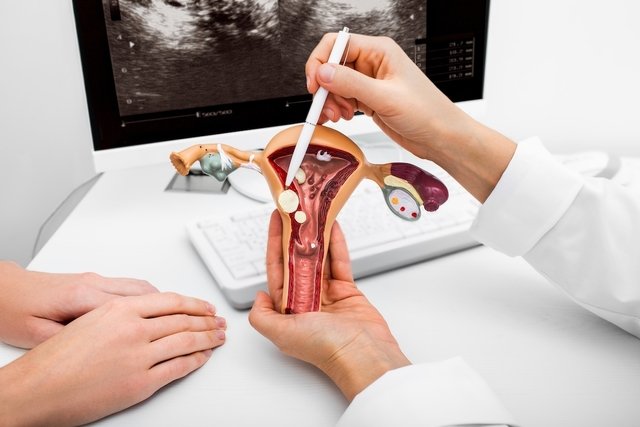Treatment for fibroids in the uterus involves medications such as non-steroidal anti-inflammatory drugs and hormonal contraceptives and, in the most serious cases, surgery, which ranges from removing the fibroid to removing the uterus to alleviate symptoms such as bleeding and severe pain.
Myoma in the uterus is a benign tumor that occurs in the muscle that exists in the wall of the uterus and does not always require specific treatment. Furthermore, even when indicated, medications are generally not able to cure myoma and are effective in relieving symptoms. Understand better what fibroids in the uterus are.
It is important that the gynecologist is consulted so that the fibroid can be analyzed and the most appropriate treatment can be indicated, if necessary.

Medications for non-uterine fibroids
Some medications that may be indicated in the treatment of myoma in the uterus are:
1. Gonadotropin-releasing hormone agonists
Gonadotropin-releasing hormone agonist medications, such as leuprolide acetate, goserelin acetate or triptorelin, are capable of blocking hormone production, causing the woman to temporarily enter menopause, which results in a decrease in the size of the fibroid. Furthermore, due to the interruption of menstruation, these medications can help improve anemia, caused by excessive bleeding.
Generally, these medications are indicated as treatment before surgery to remove the fibroid, facilitating the procedure and reducing the risk of complications.
Prolonged use of these medications can cause side effects such as mood changes, decreased libido and osteoporosis, and is normally not recommended. Furthermore, when use is stopped, the fibroid usually grows back.
2. Progestagens
Progestin medications, such as medroxyprogesterone or levonorgestrel, may be effective in reducing bleeding caused by fibroids, and are indicated in some cases.
Furthermore, levonorgestrel can be released from some types of intrauterine devices (IUDs), acting directly on the wall of the uterus. This way, in addition to controlling bleeding, it avoids side effects, such as nausea and headache, as it is less absorbed by the body. Find out what the IUD with levonorgestrel is and what it is for.
3. Tranexamic acid
Tranexamic acid is a non-hormonal medicine, which promotes blood clotting, and is generally indicated in cases where the fibroid in the uterus causes heavy bleeding, and its use is recommended for up to 5 days in case of bleeding. See other uses of tranexamic acid and the most common side effects.
4. Combined hormonal contraceptives
Contraceptives containing estrogen and progesterone may be recommended by your doctor and although they do not treat the fibroid or reduce its size, they can help control bleeding during the menstrual period. Know how to take contraceptives.
5. Nonsteroidal anti-inflammatories
Non-steroidal anti-inflammatory drugs, such as ibuprofen or naproxen, work by reducing the production of inflammatory substances and are generally indicated in case of pain or bleeding caused by myoma. Additionally, they tend to be most effective when started a day or two before the start of your period.
However, they are less effective than tranexamic acid, oral hormonal contraceptives, or levonorgestrel IUDs in reducing bleeding.
6. Iron supplements
Iron supplementation is generally indicated in cases where bleeding caused by myoma causes anemia, which is more common in women with heavy or prolonged bleeding. Check out what iron supplements are for and how to take them.
Myoma surgery
Myoma in the uterus can be treated through surgery, such as myomectomy, uterine artery embolization or even hysterectomy, and its indication usually depends on the severity of the symptoms caused by the fibroid, response to other treatments, age and the woman’s desire. of getting pregnant. See how surgery for uterine fibroids is performed.
Embolization: what it is, what it is for, how it is done (and care)
Bibliography
- STATPEARLS. Uterine Leiomyomata. 2021. Available at: <https://www.ncbi.nlm.nih.gov/books/NBK546680/>. Accessed on September 16, 2022
- GIULIANI, Emma; SANIE-AS, Sawsan; MARSH, Erica. Epidemiology and management of uterine fibroids. Int J Gynaecol Obstet. Vol.149, n.1. 3-9, 2020
- VILOS, George A. et al. The management of uterine leiomyomas. J Obstet Gynaecol Can. Vol.37, n.2. 157-178, 2015

Sign up for our newsletter and stay up to date with exclusive news
that can transform your routine!
Warning: Undefined array key "title" in /home/storelat/public_html/wp-content/plugins/link-whisper-premium/templates/frontend/related-posts.php on line 12
Warning: Undefined array key "title_tag" in /home/storelat/public_html/wp-content/plugins/link-whisper-premium/templates/frontend/related-posts.php on line 13




